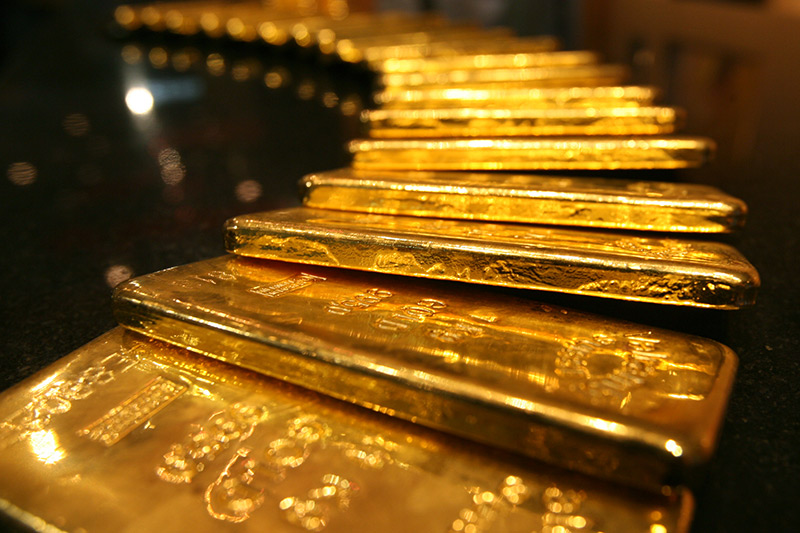Investing.com - Gold prices rose in Asian trading on Tuesday, brushing off U.S. and European losses on fears Europe's economy may be battling stronger headwinds than once feared.
On the Comex division of the New York Mercantile Exchange, gold futures for December delivery were up 0.26% at USD1,769.25 a troy ounce, up from a session low of USD1,766.95 and down from a high of USD1,769.65 a troy ounce early during the session.
Gold futures were likely to test support at USD1,755.75 a troy ounce, Thursday's low, and resistance at USD1,787.55, Friday's high.
Gold prices dropped in U.S. and European trading sessions earlier, as the yellow metal's traditional hedge, the dollar, rose after weak German business sentiment figures hit wire.
The Ifo institute said its business climate index for Germany fell to its lowest level since March 2010, stoking worries that the European debt crisis is fraying nerves in Europe's largest economy.
The Ifo index fell to 101.4 in September from 102.3 in August, the fifth consecutive monthly decline and well below expectations for a 102.5 reading.
Ongoing uncertainty as to whether Spain will seek a bailout pushed the euro and higher yielding currencies down earlier and with them, gold prices as well.
On Thursday Madrid will unveil a draft budget for next year and announce structural reforms, while the results of the country's bank stress tests are due on Friday.
Elsewhere, the Moody’s ratings agency should wrap up a ratings review on Spain later this week.
Spain’s economy minister said the country would not rush to seek external financial aid, though press reports have said the country is quietly drawing up blueprints to formally seek assistance.
By Asian trading on Tuesday, however, bottom fishers snapped up positions in the precious metal despite fears Asian economies may be cooling their growth rates.
The U.S. Federal Reserve is currently running a third round of quantitative easing, a monetary stimulus tool that sees the U.S. central bank buy USD40 billion in mortgage-backed securities a month on an open-ended basis to spur recovery.
Such policy tools weaken the greenback and make gold an attractive hedge.
Elsewhere on the Comex, silver for December delivery was up 0.64% and trading at USD34.200 a troy ounce, while copper for December delivery was up 0.25% and trading at USD3.750 a pound.
On the Comex division of the New York Mercantile Exchange, gold futures for December delivery were up 0.26% at USD1,769.25 a troy ounce, up from a session low of USD1,766.95 and down from a high of USD1,769.65 a troy ounce early during the session.
Gold futures were likely to test support at USD1,755.75 a troy ounce, Thursday's low, and resistance at USD1,787.55, Friday's high.
Gold prices dropped in U.S. and European trading sessions earlier, as the yellow metal's traditional hedge, the dollar, rose after weak German business sentiment figures hit wire.
The Ifo institute said its business climate index for Germany fell to its lowest level since March 2010, stoking worries that the European debt crisis is fraying nerves in Europe's largest economy.
The Ifo index fell to 101.4 in September from 102.3 in August, the fifth consecutive monthly decline and well below expectations for a 102.5 reading.
Ongoing uncertainty as to whether Spain will seek a bailout pushed the euro and higher yielding currencies down earlier and with them, gold prices as well.
On Thursday Madrid will unveil a draft budget for next year and announce structural reforms, while the results of the country's bank stress tests are due on Friday.
Elsewhere, the Moody’s ratings agency should wrap up a ratings review on Spain later this week.
Spain’s economy minister said the country would not rush to seek external financial aid, though press reports have said the country is quietly drawing up blueprints to formally seek assistance.
By Asian trading on Tuesday, however, bottom fishers snapped up positions in the precious metal despite fears Asian economies may be cooling their growth rates.
The U.S. Federal Reserve is currently running a third round of quantitative easing, a monetary stimulus tool that sees the U.S. central bank buy USD40 billion in mortgage-backed securities a month on an open-ended basis to spur recovery.
Such policy tools weaken the greenback and make gold an attractive hedge.
Elsewhere on the Comex, silver for December delivery was up 0.64% and trading at USD34.200 a troy ounce, while copper for December delivery was up 0.25% and trading at USD3.750 a pound.
